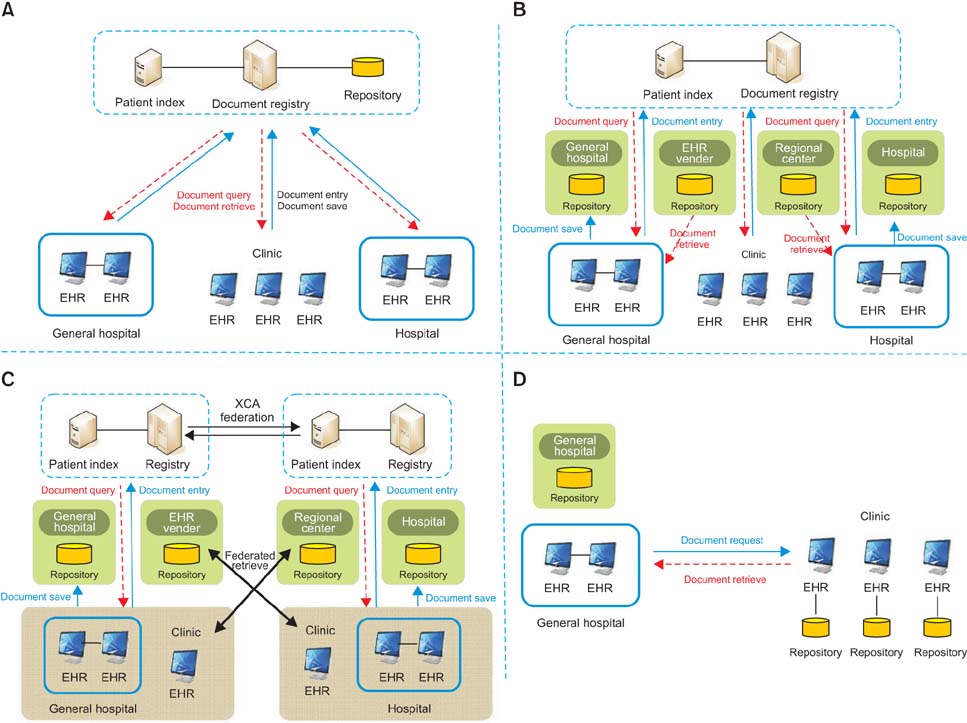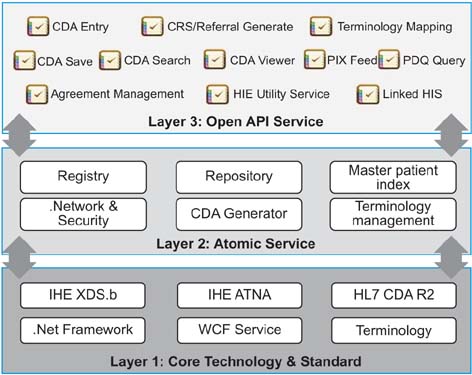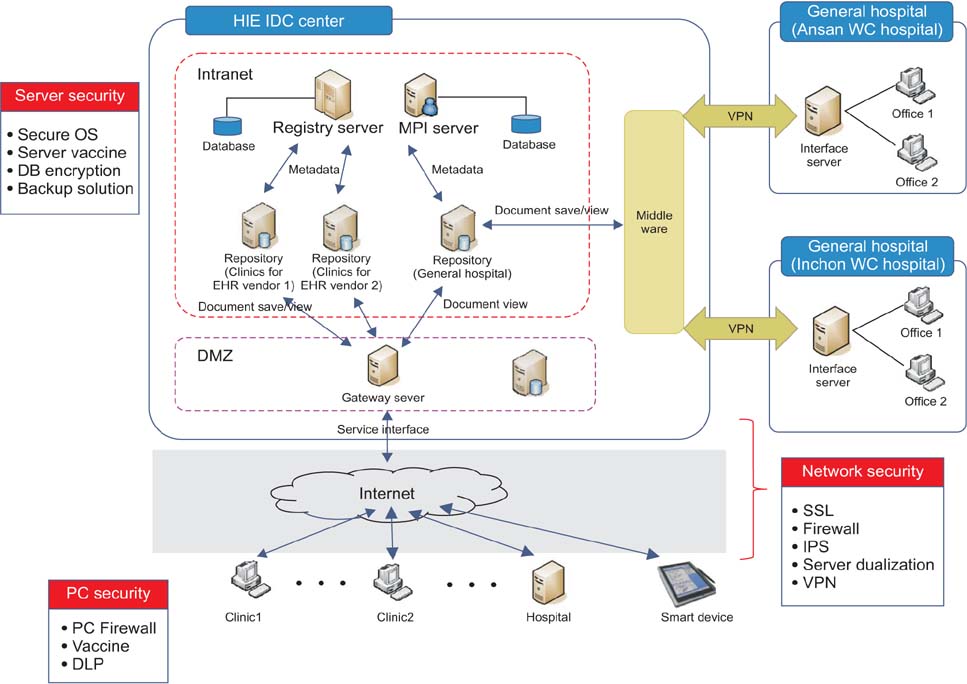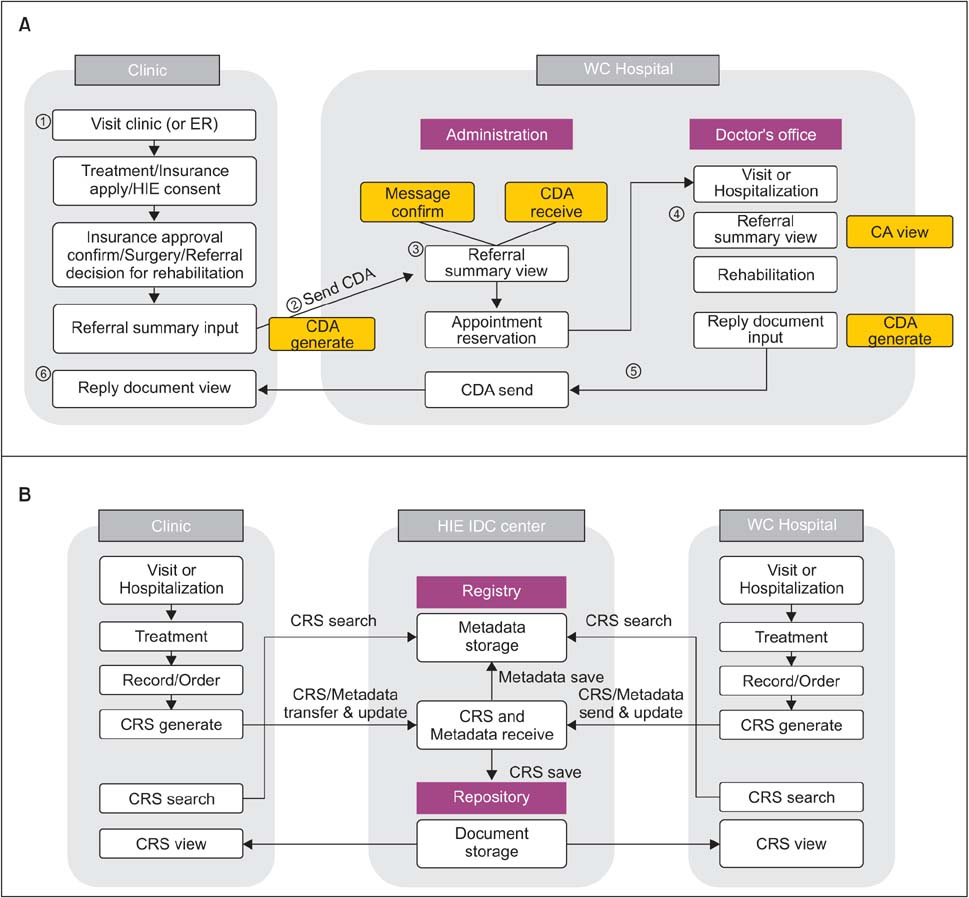Developing a Common Health Information Exchange Platform to Implement a Nationwide Health Information Network in South Korea
- Affiliations
-
- 1R&D Center, ezCaretech Co. Ltd., Seoul, Korea.
- 2Center for Medical Informatics, Seoul National University Bundang Hospital, Seongnam, Korea. yoosoo0@snu.ac.kr
- 3IT Convergence Policy Team, National IT Industry Promotion Agency, Seoul, Korea.
- KMID: 2284594
- DOI: http://doi.org/10.4258/hir.2015.21.1.21
Abstract
OBJECTIVES
We aimed to develop a common health information exchange (HIE) platform that can provide integrated services for implementing the HIE infrastructure in addition to guidelines for participating in an HIE network in South Korea.
METHODS
By exploiting the Health Level 7 (HL7) Clinical Document Architecture (CDA) and Integrating the Healthcare Enterprise (IHE) Cross-enterprise Document Sharing-b (XDS.b) profile, we defined the architectural model, exchanging data items and their standardization, messaging standards, and privacy and security guidelines, for a secure, nationwide, interoperable HIE. We then developed a service-oriented common HIE platform to minimize the effort and difficulty of fulfilling the standard requirements for participating in the HIE network. The common platform supports open application program interfaces (APIs) for implementing a document registry, a document repository, a document consumer, and a master patient index. It could also be used for testing environments for the implementation of standard requirements.
RESULTS
As the initial phase of implementing a nationwide HIE network in South Korea, we built a regional network for workers' compensation (WC) hospitals and their collaborating clinics to share referral and care record summaries to ensure the continuity of care for industrially injured workers, using the common HIE platform and verifying the feasibility of our technologies.
CONCLUSIONS
We expect to expand the HIE network on a national scale with rapid support for implementing HL7 and IHE standards in South Korea.
Keyword
MeSH Terms
Figure
Cited by 4 articles
-
Current National Approach to Healthcare ICT Standardization: Focus on Progress in New Zealand
Young-Taek Park, Koray Atalag
Healthc Inform Res. 2015;21(3):144-151. doi: 10.4258/hir.2015.21.3.144.Adoption of Electronic Health Records: A Roadmap for India
Sunil Kumar Srivastava
Healthc Inform Res. 2016;22(4):261-269. doi: 10.4258/hir.2016.22.4.261.Current Status of Electronic Medical Record Systems in Hospitals and Clinics in Korea
Young-Taek Park, Dongwoon Han
Healthc Inform Res. 2017;23(3):189-198. doi: 10.4258/hir.2017.23.3.189.Technology and Policy Challenges in the Adoption and Operation of Health Information Exchange Systems
Hyerim Ji, Sooyoung Yoo, Eun-Young Heo, Hee Hwang, Jeong-Whun Kim
Healthc Inform Res. 2017;23(4):314-321. doi: 10.4258/hir.2017.23.4.314.
Reference
-
1. Shade SB, Chakravarty D, Koester KA, Steward WT, Myers JJ. Health information exchange interventions can enhance quality and continuity of HIV care. Int J Med Inform. 2012; 81(10):e1–e9.
Article2. Kaelber DC, Bates DW. Health information exchange and patient safety. J Biomed Inform. 2007; 40:6 Suppl. S40–S45.
Article3. Dobbs D, Trebatoski M, Revere D. The Northwest public health information exchange's accomplishments in connecting a health information exchange with public health. Online J Public Health Inform. 2010; 2(2):e5.
Article4. Shapiro JS, Mostashari F, Hripcsak G, Soulakis N, Kuperman G. Using health information exchange to improve public health. Am J Public Health. 2011; 101(4):616–623.
Article5. Vest JR, Miller TR. The association between health information exchange and measures of patient satisfaction. Appl Clin Inform. 2011; 2(4):447–459.
Article6. Feldman SS, Schooley BL, Bhavsar GP. Health information exchange implementation: lessons learned and critical success factors from a case study. JMIR Med Inform. 2014; 2(2):e19.
Article7. Dolin RH, Alschuler L, Boyer S, Beebe C, Behlen FM, Biron PV, et al. HL7 Clinical Document Architecture, Release 2. J Am Med Inform Assoc. 2006; 13(1):30–39.
Article8. Health Level Seven International. HL7 Implementation Guide for CDA Release 2 - Level 1 and 2 - Care Record Summary (US realm) [Internet]. Ann Arbor (MI): Health Level Seven International;2006. cited at 2015 Jan 5. Available from: http://www.hl7.org/implement/standards/product_brief.cfm?product_id=29.9. Health Level Seven International. HL7 Implementation Guide: CDA Release 2 - Continuity of Care Document (CCD) [Internet]. Ann Arbor (MI): Health Level Seven International;2007. cited at 2015 Jan 5. Available from: ftp://ftp.ihe.net/TF_Implementation_Material/PCC/schemas/ccd/CCD-final.pdf.10. HL7. HL7 Impementation Guide for CDA Release 2: IHE Health Story Consolidation, Release 1.1 (US realm) [Internet]. Ann Arbor (MI): Health Level Seven International;2011. cited at 2015 Jan 5. Available from: http://wiki.siframework.org/file/view/CDAR2_IG_IHE_CONSOL_R1_DSTU_2011DEC.pdf/322738944/CDAR2_IG_IHE_CONSOL_R1_DSTU_2011DEC.pdf.11. Korea Health and Welfare Information Service [Internet]. Seoul: Korea Health and Welfare Information Service;c2014. cited at 2015 Jan 5. Available from: http://www.khwis.or.kr/eng/main.do.12. Thorn SA, Carter MA, Bailey JE. Emergency physicians' perspectives on their use of health information exchange. Ann Emerg Med. 2014; 63(3):329–337.
Article13. Vest JR, Gamm LD. Health information exchange: persistent challenges and new strategies. J Am Med Inform Assoc. 2010; 17(3):288–294.
Article14. Zwaanswijk M, Verheij RA, Wiesman FJ, Friele RD. Benefits and problems of electronic information exchange as perceived by health care professionals: an interview study. BMC Health Serv Res. 2011; 11:256.
Article
- Full Text Links
- Actions
-
Cited
- CITED
-
- Close
- Share
- Similar articles
-
- A Web-Based Medical Information Exchange System Using HL7 Protocols
- Megatrends and Perspectives of Emerging Medical Services
- Adoption of Electronic Health Records: A Roadmap for India
- The Study about Information of Skin Disease on the Internet: Acne
- Modelling and comparing hospitals' information systems in Japan and Germany





